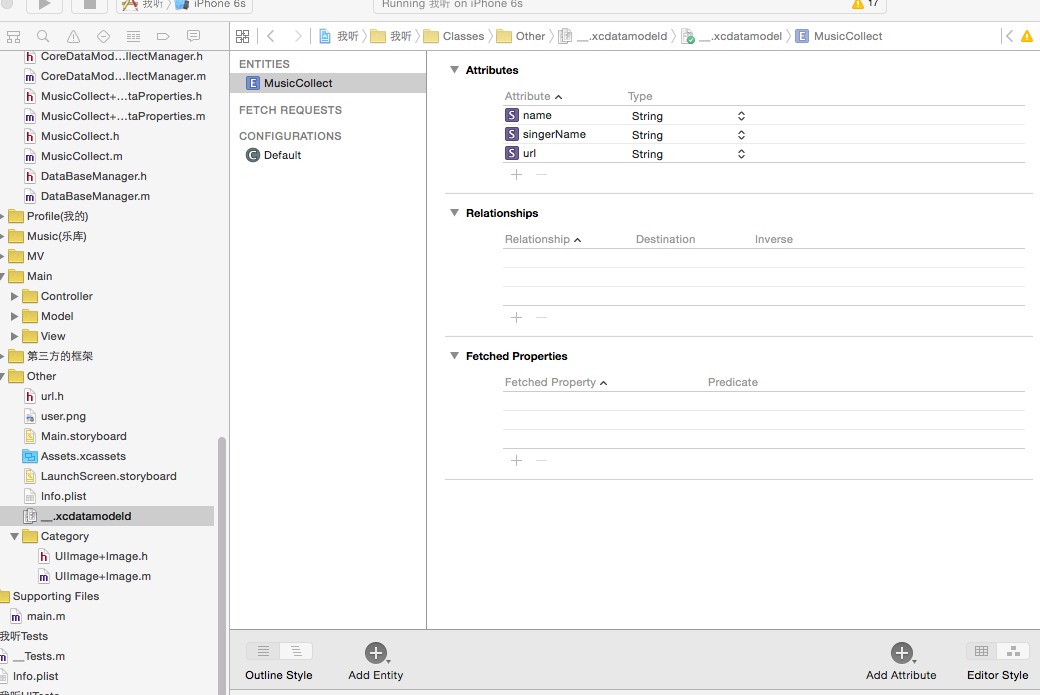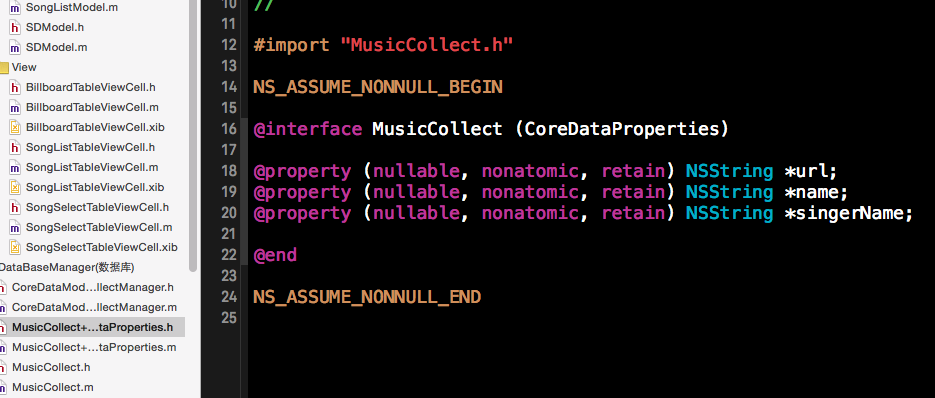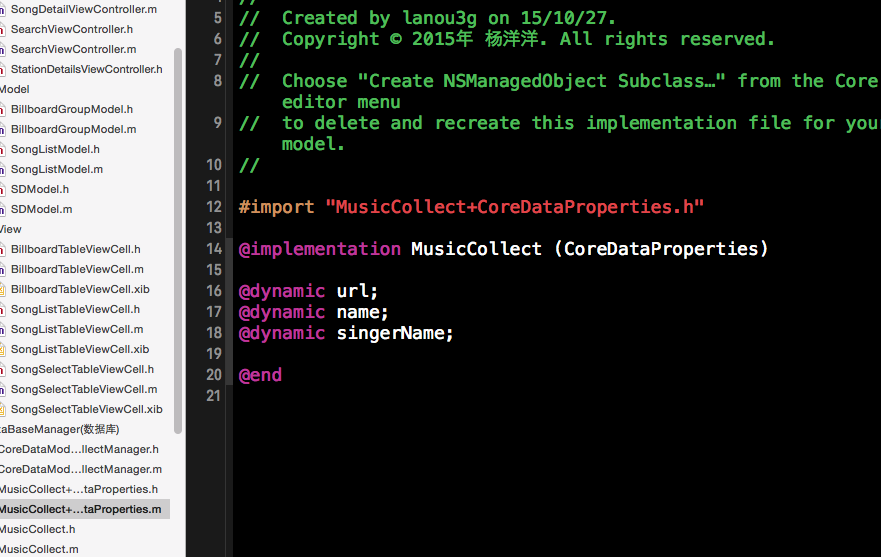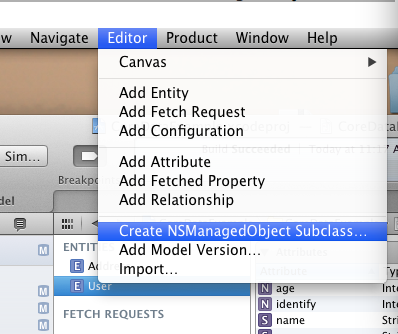Core Data数据持久化是对SQLite的一个升级,它是ios集成的,在说Core Data之前,我们先说说在CoreData中使用的几个类。
(1)NSManagedObjectModel(被管理的对象模型)
相当于实体,不过它包含 了实体间的关系
(2)NSManagedObjectContext(被管理的对象上下文)
操作实际内容
作用:插入数据 查询 更新 删除
(3)NSPersistentStoreCoordinator(持久化存储助理)
相当于数据库的连接器
(4)NSFetchRequest(获取数据的请求)
相当于查询语句
(5)NSPredicate(相当于查询条件)
(6)NSEntityDescription(实体结构)
(7)后缀名为.xcdatamodel的包
里面的.xcdatamodel文件,用数据模型编辑器编辑
编译后为.momd或.mom文件,这就是为什么文件中没有这个东西,而我们的程序中用到这个东西而不会报错的原因
首先我们要建立模型对象

生成模型对象的实体 创建好所需要的Attribute 和Type
然后 Create NSManagerObject…..
下面这个截图是创建后自动生成的实体


解释一下dynamic
dynamic和synthesize有什么区别呢?dynamic的setter和getter方法不能自已定义
然后新建一个类进行增删改查
.h文件
#import <UIKit/UIKit.h>
#import "MusicCollect+CoreDataProperties.h"
@class AppDelegate;
@interface CoreDataModelCollectManager : NSObject
//单例
+ (CoreDataModelCollectManager *)shareCoreDataModelManager;
//保存
- (void)saveMusicModelWithSongName:(NSString *)songName
singerName:(NSString *)singerName
url:(NSString *)url;
//删除
- (void)deleteMusicWithSongName:(NSString *)songName;
//查找
- (NSArray *)fetchSongWithSongName:(NSString *)songName;
//更改
- (void)updateMusicWithSongName:(NSString *)songName
newSongName:(NSString *)newSongName
newSingerName:(NSString *)newSingerName
newUrl:(NSString *)newUrl;
@end.m文件
#import "CoreDataModelCollectManager.h"
#import "AppDelegate.h"
@interface CoreDataModelCollectManager ()
@property (nonatomic, strong) AppDelegate *appDelegate;
@end
static CoreDataModelCollectManager *manager;
@implementation CoreDataModelCollectManager
//单例
+ (CoreDataModelCollectManager *)shareCoreDataModelManager{
@synchronized(self) {
if (!manager){
manager = [[CoreDataModelCollectManager alloc] init];
manager.appDelegate = [UIApplication sharedApplication].delegate;
}
}
return manager;
}
//保存
- (void)saveMusicModelWithSongName:(NSString *)songName
singerName:(NSString *)singerName
url:(NSString *)url{
NSMutableArray *array = [NSMutableArray arrayWithArray:[self fetchSongWithSongName:songName]];
if (array.count > 0){
NSLog(@"已有重复数据");
return;
}
NSEntityDescription *description = [NSEntityDescription entityForName:@"MusicCollect" inManagedObjectContext:self.appDelegate.managedObjectContext];
MusicCollect *music = [[MusicCollect alloc] initWithEntity:description insertIntoManagedObjectContext:self.appDelegate.managedObjectContext];
music.name = songName;
music.singerName = singerName;
music.url = url;
NSString *documentsPath = [NSSearchPathForDirectoriesInDomains(NSDocumentDirectory, NSUserDomainMask, YES) firstObject];
NSLog(@"%@", documentsPath);
[self.appDelegate saveContext];
}
//删除
- (void)deleteMusicWithSongName:(NSString *)songName{
NSMutableArray *array = [NSMutableArray arrayWithArray:[self fetchSongWithSongName:songName]];
if (array.count > 0){
for (MusicCollect *music in array) {
[self.appDelegate.managedObjectContext deleteObject:music];
}
}
}
//查找
- (NSArray *)fetchSongWithSongName:(NSString *)songName{
NSFetchRequest *fetchRequest = [[NSFetchRequest alloc] init];
NSEntityDescription *entity = [NSEntityDescription entityForName:@"MusicCollect" inManagedObjectContext:self.appDelegate.managedObjectContext];
[fetchRequest setEntity:entity];
// Specify criteria for filtering which objects to fetch
NSPredicate *predicate = [NSPredicate predicateWithFormat:@"name = '%@'", songName];
[fetchRequest setPredicate:predicate];
// Specify how the fetched objects should be sorted
NSSortDescriptor *sortDescriptor = [[NSSortDescriptor alloc] initWithKey:@"name"
ascending:YES];
[fetchRequest setSortDescriptors:[NSArray arrayWithObjects:sortDescriptor, nil]];
NSError *error = nil;
NSArray *fetchedObjects = [self.appDelegate.managedObjectContext executeFetchRequest:fetchRequest error:&error];
if (fetchedObjects == nil) {
NSLog(@"没有搜到对应歌曲");
}
return fetchedObjects;
}
//更改
- (void)updateMusicWithSongName:(NSString *)songName
newSongName:(NSString *)newSongName
newSingerName:(NSString *)newSingerName
newUrl:(NSString *)newUrl{
}
@end






















 142
142

 被折叠的 条评论
为什么被折叠?
被折叠的 条评论
为什么被折叠?








